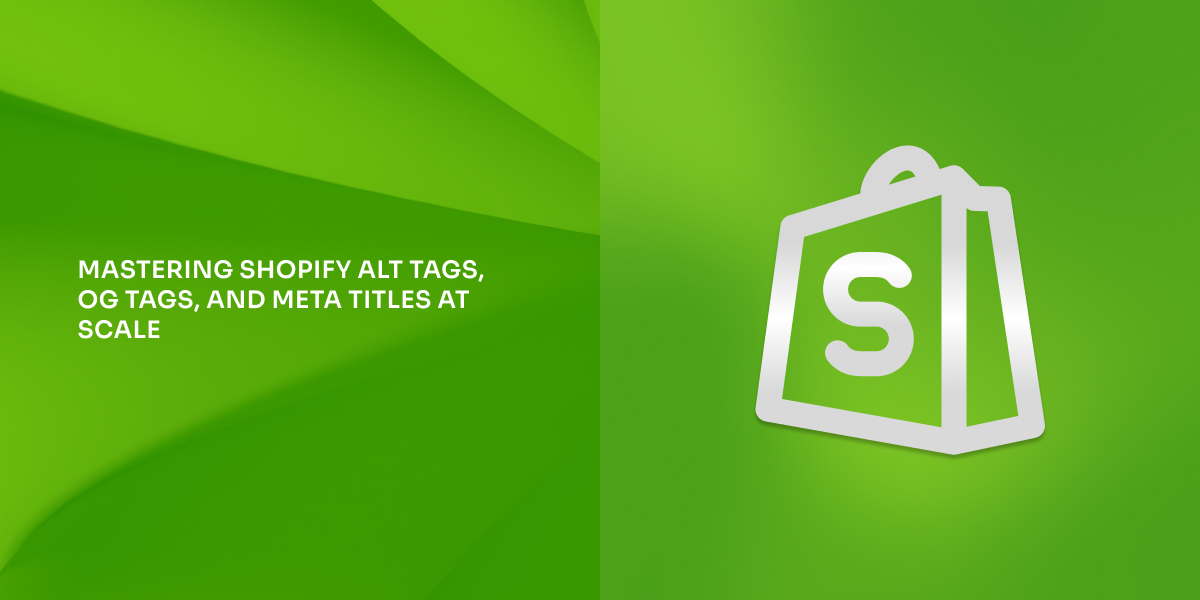Mastering Shopify alt tags, OG tags, and meta titles at scale

A writer-marketing assistant with a background in sociology and research, Alyanna is part of the marketing team at 1902 Software. As one of the newer members, she brings a fresh perspective and a growing curiosity about how technology helps businesses—especially in the B2B sector—connect with their audiences more effectively. She contributes to the team’s efforts in creating marketing materials and supporting initiatives for both 1902 Software and WriteText.ai.

For Shopify merchants managing hundreds—or even thousands—of products, manually optimizing every Shopify alt tag, Open Graph (OG) element, and meta title can feel endless. Yet these small details are what shape your store’s visibility in search results and how your products appear when shared on social media.
Think about it: when someone searches for “organic cotton yoga pants” or shares your product link on Facebook, your metadata decides whether they click your store or someone else’s.
As your catalog grows, keeping everything optimized gets tougher. WriteText.ai solves this by automating Shopify copywriting and metadata creation at scale—so you can maintain quality, consistency, and visibility without endless manual edits. In this guide, we’ll cover how to handle alt tags, OG tags, and meta titles efficiently across your Shopify store, and how WriteText.ai simplifies the entire process.
Why metadata matters more than ever
Search engines have moved way beyond simple keyword matching. Google now looks at semantic relevance, user intent, and overall content quality—much of which comes down to how well you've set up your descriptive metadata. According to Google's Search Central documentation, title elements are the headlines people see in search results, and they directly affect whether someone clicks through to your store.
Image alt attributes pull double duty: they make your site accessible to screen readers (keeping you WCAG compliant) while giving Google Images the context it needs to understand your visuals. A WebAIM study on image accessibility shows that well-written alt text improves both user experience and how discoverable your products are in search.
Then there's Open Graph tags—these control what shows up when someone shares your products on Facebook, LinkedIn, or Pinterest. Skip proper OG setup and you'll get generic, uninspiring previews that don't convert. The Open Graph Protocol standardizes how this metadata works, so your products look good no matter where they're shared.
Understanding Shopify’s metadata architecture
Shopify stores metadata across several locations within its admin interface and theme files. Product titles and descriptions live in the primary product editor, while meta titles and descriptions occupy dedicated SEO fields. Shopify alt tags are assigned individually to each product image through the media manager, and Open Graph tags typically generate automatically from these existing fields—though customization requires theme-level adjustments.
This distributed structure creates friction when scaling. Editing 500 products manually means navigating through 500 separate admin pages, uploading or editing images multiple times, and maintaining consistency across all these touchpoints. Even small catalogs experience this burden when launching seasonal collections or rebranding.
Theme compatibility adds another layer of complexity. While modern Shopify themes (particularly those built on Online Store 2.0) include structured metadata fields, older themes may require Liquid template modifications to properly output custom OG tags or advanced alt text implementations. Understanding your theme's architecture before implementing mass changes prevents conflicts and ensures proper rendering.
Implementing alt tags that drive discovery
Good Shopify alt tags hit a sweet spot: they're descriptive, accurate, and include relevant keywords without feeling forced. Skip the generic "product image" labels and the keyword-stuffed nonsense like "buy cheap organic cotton yoga pants sale discount." Instead, describe what's actually in the image: "Woman in downward dog pose wearing navy organic cotton yoga pants.”
This approach works for everyone. Screen reader users get meaningful descriptions. Search engines get context that matches what people are actually searching for. Google's official image SEO documentation emphasizes that descriptive, natural-language alt text helps search engines understand image content while improving accessibility for all users.
For Shopify stores, implementing alt tags at scale requires a systematic approach:
- Product photography naming conventions. Establish consistent file naming before upload. A clear system like "product-name-angle-color.jpg" creates a foundation for bulk alt text generation. While Shopify doesn't automatically convert filenames to alt text, organized naming helps when using automation tools or apps.
- Variant-specific descriptions. Products with multiple colors or styles deserve unique alt text for each image. "Ceramic coffee mug in matte black" is meaningfully different from "ceramic coffee mug in glossy white"—for users and for image search rankings targeting those specific attributes.
- Distinguish lifestyle from product shots. Lifestyle images showing products in use warrant different descriptive approaches than isolated product shots. "Kitchen countertop with white ceramic mug next to laptop" provides context that pure product descriptions don't capture, potentially matching broader informational searches.
WriteText.ai for Shopify's autowrite capabilities streamline this process by analyzing product data, category information, and image context to generate descriptive alt text that maintains consistency across your catalog while adapting to each product's unique attributes.
Open Graph optimization for social commerce
When customers share your products on social platforms, Open Graph tags control what shows up in the preview—the image, title, and description. Shopify's default setup pulls from your existing product data, but customizing these tags strategically can seriously improve your social conversion rates.
Here are the core OG tags for ecommerce:
- og:title: Often mirrors your product title but may benefit from social-optimized phrasing
- og:description: Should emphasize benefits and urgency rather than technical specifications
- og:image: Requires careful consideration of aspect ratios (Facebook recommends 1200x630px for optimal display)
- og:url: The canonical product URL ensuring traffic routes correctly
- og:type: Should be set to "product" for ecommerce items
Implementing custom OG tags in Shopify typically requires editing your theme's theme.liquid or product.liquid template files. The basic Liquid syntax looks like:
<meta property="og:title" content="{% raw %}{{ product.title }}">
<meta property="og:description" content="{{ product.description | strip_html | truncatewords: 30 }}" />
<meta property="og:image" content="{{ product.featured_image | img_url: '1200x630', crop: 'center' }}" />
For merchants uncomfortable with theme editing, apps that manage metadata can inject these tags without manual Liquid modifications. WriteText.ai integrates directly with Shopify's metadata fields, ensuring OG tags populate correctly across your store without theme conflicts.
Testing matters. Use Facebook's Sharing Debugger and LinkedIn's Post Inspector to verify how your pages render when shared. These tools also clear cached metadata, ensuring updates appear correctly.
Strategic meta title and description optimization
While product titles serve internal organization and on-page display, meta titles (the <title> tag in HTML) directly influence search result appearance and click-through rates. Advanced Web Ranking's CTR study consistently shows that positions 1-3 in search results receive vastly higher clicks—but compelling meta titles can improve CTR even from lower positions.
Effective meta titles for Shopify products follow these patterns:
- Front-Load Keywords. Place primary terms early: "Organic Cotton Yoga Pants | Women's Activewear | [Brand Name]" performs better than "[Brand Name] | Yoga Pants Made From Organic Cotton."
- Maintain Readability. Search engines may truncate titles beyond 60 characters (or approximately 600 pixels). Prioritize essential information within this constraint while ensuring full titles remain grammatically coherent.
- Brand Positioning. Including brand names benefits recognition and trust, but consider whether brand-first or product-first ordering makes sense for your market position. Established brands benefit from leading with their name; newer stores often perform better with descriptive-first titles.
Meta descriptions don't directly affect rankings, but they absolutely influence whether people click. These 155-160 character summaries should clearly explain product benefits and include a subtle call-to-action. Don't just duplicate your on-page descriptions—treat meta descriptions like ad copy designed to win clicks from search results.
WriteText.ai's Shopify copywriting engine generates meta titles and descriptions that balance keyword optimization with persuasive messaging, adapting tone and structure based on product categories and competitive positioning.
Scaling implementation with WriteText.ai
Manual optimization becomes unsustainable beyond small catalogs. WriteText.ai's platform addresses this through intelligent automation that respects ecommerce best practices:
- Bulk processing. Upload product lists or connect directly to Shopify's API to process entire collections at once. The system analyzes existing data, spots optimization opportunities, and generates compliant metadata across all elements.
- Template customization. Set up brand-specific rules for how your Shopify alt tags, OG tags, and meta elements should be structured. These templates keep everything consistent while allowing product-specific variations.
- Theme integration. The app works within Shopify's metafield system, avoiding theme conflicts while ensuring proper output regardless of your template structure. Changes flow through standard Shopify update mechanisms.
- Quality assurance. Automated generation doesn't mean unreviewed output. The platform includes review workflows where teams can approve, adjust, or regenerate content before publishing, maintaining quality control at scale.
- Continuous optimization. As products update, seasonal promotions launch, or inventory changes, WriteText.ai can refresh metadata to reflect current positioning and availability, keeping your store's technical SEO aligned with operational reality.
- Bulk processing. Upload product lists or connect directly to Shopify's API to process entire collections simultaneously. The system analyzes existing data, identifies optimization opportunities, and generates compliant metadata across all elements.
- Template customization. Establish brand-specific rules for how Shopify alt tags, OG tags, and meta elements should be structured. These templates ensure consistency while allowing product-specific variations.
- Theme integration. The app works within Shopify's metafield system, avoiding theme conflicts while ensuring proper output regardless of your template structure. Changes propagate through standard Shopify update mechanisms.
- Quality assurance. Automated generation doesn't mean unreviewed output. The platform includes review workflows where teams can approve, adjust, or regenerate content before publication, maintaining quality control at scale.
- Continuous optimization. As products update, seasonal promotions launch, or inventory changes, WriteText.ai can refresh metadata to reflect current positioning and availability, keeping your store's technical SEO aligned with operational reality.
Technical considerations and best practices
Successfully implementing metadata optimization requires attention to several technical details:
- Avoid duplication. Identical meta titles or descriptions across multiple products confuse search engines about which page to rank for specific queries. Ensure uniqueness, especially within similar product variations.
- Monitor character limits. While Shopify's fields allow longer input, search engines and social platforms truncate beyond specific thresholds. Build constraints into your workflow to prevent cut-off text.
- Structured data compatibility. Ensure your metadata approach aligns with structured data (schema.org) implementation. Product schema should reference the same information reflected in OG tags and meta descriptions for consistency.
- International considerations. Multi-language or multi-currency stores require localized metadata. Shopify Markets and translation apps should extend to all metadata fields, not just visible page content.
- Performance impact. While metadata itself doesn't slow page loads, inefficient app implementations or theme modifications can. Test page speed after implementing new metadata solutions to ensure technical SEO gains aren't offset by performance losses.
Measuring impact and iterating
Metadata optimization delivers measurable results across multiple channels. Track these metrics to evaluate success:
- Organic click-through rates from Google Search Console for title/description effectiveness
- Image search traffic from Google Analytics to assess alt tag performance
Social engagement metrics (shares, clicks from social referrals) for OG tag optimization - Accessibility compliance scores from tools like WAVE or Lighthouse to verify alt text implementation
Continuous improvement requires testing variations, analyzing competitor approaches, and adapting to algorithm updates. What works for one product category may not transfer to another, and seasonal trends influence optimal messaging.
Key takeaways
Optimizing Shopify alt tags, Open Graph elements, and meta titles isn't optional for competitive ecommerce stores—it's foundational infrastructure that compounds over time. Manual approaches don't scale, but automated solutions without strategic oversight risk generic, ineffective output.
WriteText.ai bridges this gap by combining ecommerce expertise with efficient automation, letting merchants implement enterprise-level Shopify copywriting and metadata optimization without enterprise resources. As search engines and social platforms increasingly prioritize well-structured, contextual information, stores that systematically optimize these elements gain compounding advantages in visibility, traffic quality, and conversion performance.
The most successful Shopify merchants treat metadata optimization as an ongoing discipline rather than a one-time task, continuously refining their approach as their catalogs evolve and their understanding of customer search behavior deepens.